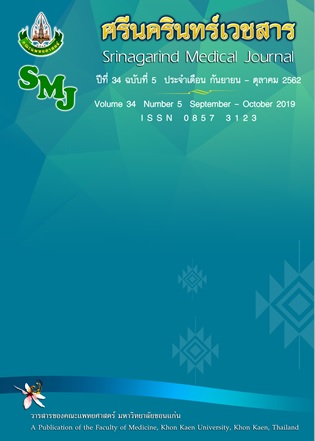Health Risk Assessment of Inhalation Exposure to Respirable Dust among Workers in a Rice Mill in Kamphaeng Phet Province
Keywords:
Health risk assessment; Respirable dust; Affecting factor; Rice mill workerAbstract
Background and Objective: Dust represents a significant occupational problem among rice mill workers, especially respirable dust of aerodynamic diameter ≤10 µm. It can penetrate into the lower part of respiratory system. The objective of this study was to determine the health risk assessment of inhalation exposure to respirable dust among workers in a rice mill in Kamphaeng Phet province. Moreover, factors affecting health risk were examined.
Methods: Data were collected from 44 workers of a rice mill in Kamphaeng Phet Province. Collected data were divided into 2 parts: 1) Inhalation exposure to respirable dust was collected in breathing zone of the workers via personal sampling technique for a full period of work and analyzed by gravimetric method, in accordance to NIOSH Manual of Analytical Method number 0600; 2) Personal characteristics and working characteristics were collected using questionnaire. All of data were assessed health risk according to United States Environmental Protection Agency (U.S. EPA). Simple regression analysis was used to analyze the factors affecting health risk.
Results: The results showed that most of workers were female (65.9%). Their average respirable dust exposure within the breathing zone was 0.0788 ± 0.0623 mg/m3. The results of health risk assessment of inhalation exposure to respirable dust in terms of non-cancer effect indicated that the average hazard quotient was 0.56 ± 0.42. Furthermore, 90.91% of workers had hazard quotient in low level. This study found that 2 factors had a significant effect on hazard quotient i.e., respirable dust exposure (p < 0.001) and working experience (p = 0.032).
Conclusion: The finding revealed that a risk management program is necessary in order to reduce and control the risks to an acceptable risk i.e. decreasing the respirable dust exposure, especially in the experienced workers.
References
2. สำนักงานพัฒนาวิทยาศาสตร์และเทคโนโลยีแห่งชาติ. ยุทธศาสตร์วิจัยและพัฒนาอุตสาหกรรมข้าว (พ.ศ. 2554-2559) ภายใต้แผนกลยุทธ์การวิจัยและพัฒนา สวทช. ระยะที่ 2 พ.ศ. 2554 – 2559.
ม.ป.ท.: ม.ป.พ., 2555.
3. Pande BN, Traczyk EK, Prazmo Z, Skorska C, Sitkowska J, Dutkiewicz J. Occupational biohazards in agricultural dusts from India. Agric Environ Med 2000; 7: 133–9.
4. วันทนี พันธุ์ประสิทธิ์. สุขศาสตร์อุตสาหกรรม กลยุทธ์ ประเมิน ควบคุมและจัดการ. กรุงเทพฯ: เบสท์กราฟฟิค เพรส, 2557.
5. กระทรวงสาธารณสุข. แผนบูรณาการด้านสิ่งแวดล้อมและสุขภาพกระทรวงสาธารณสุข ประจำปี 2558. ม.ป.ท.: ม.ป.พ., 2557.
6. Ghosh T, Gangopadhyay S, Das B. Prevalence of respiratory symptoms and disorders among rice mill workers in India. Environ Health Prev Med. 2014; 19: 226-33.
7. Eshwaramma P, Sudeena, Subhakar K, Chaladevi D. A study of Respiratory disorders in rice mill workers of the Mahaboobnagar and to compare with the control group from same district. Asian Pac J Health Sci 2016; 3:175-80.
8. Musa R, Naing L, Ahmad Z, Kamarul Y. Respiratory health of rice millers in Kelantan, Malaysia. Southeast Asian J Trop Med Public Health 2000; 31: 575-78.
9. Dewangan NK, Patil RM. Evaluation of Dust Exposure among the Workers in Agricultural Industries in North-East India. Ann Occup Hyg 2015; 59: 1091–105.
10. Occupational Safety and Health Administration. 1988 OSHA PEL Project Documentation. [cited Jan 16, 2018]. Available from: http://www.cdc.gov/niosh/pel88/dusts.html.
11. American Conference of Governmental Industrial Hygienists. Documentation of the Threshold Limit Values (TLVs) and Biological Exposure Indices (BEIs) - Particulates (Insoluble) Not Otherwise Specified (PNOS). 2001 [cited Jan 16, 2018]. Available from: http://www.cdc.gov/niosh/pel88/
DUSTS.html.
12. National Institute for Occupational Safety and Health. NIOSH Manual of Analytical Methods (NMAM), Method 0600 Particulates not otherwise regulated Respirable. 1998, Issue 3. [cited Jan 16, 2018]. Available from: https://www.cdc.gov/niosh/docs/2003-154/pdfs/0600.pdf.
13. U.S. EPA. Human Health Risk Assessment. [cited Feb 18, 2018]. Available from: https://www.epa.
gov/risk/human-health-risk-assessment
14. พรพิมล กองทิพย์. การประเมินการสัมผัสและความเสี่ยงต่อสุขภาพ. กรุงเทพฯ : เบส กราฟฟิค เพรส, 2556.
15. สำนักระบาดวิทยา กรมควบคุมโรค. สรุปรายงานการเฝ้าระวังโรค-โรคปอดจากการประกอบอาชีพ (Pneumoconiosis). 2547 [สืบค้นเมื่อ 15 มีนาคม 2561]. เข้าถึงจาก http://www.boe.moph.go.th/Annual/
Annual47/part1/50-Pneumoconiosis.pdf
16. กรมอนามัยและกรมควบคุมโรค กระทรวงสาธารณสุข. แนวทางการเฝ้าระวังพื้นที่เสี่ยงจากมลพิษทางอากาศกรณีฝุ่นละอองขนาดเล็ก. 2558 [สืบค้นเมื่อ 15 มีนาคม 2561]. เข้าถึงจาก http://www.oic.go.th/
FILEWEB/CABINFOCENTER17/DRAWER002/GENERAL/DATA0000/00000200.PDF
17. U.S. EPA. Risk Assessment Guidance for Superfund Volume I Human Health Evaluation Manual (Part A). 1989[cited 2018 March 2018]. Available from: https://www.epa.gov/sites/production/files/2015-09/documents/rags_a.pdf
18. Lemly AD. Evaluation of the Hazard Quotient Method for Risk Assessment of Selenium. Ecotoxicol Environ Saf. 1996; 35: 156–62.
19. พงศ์เทพ วิวรรธนะเดช. การประเมินความเสี่ยงด้านสุขภาพ. เชียงใหม่ : ภาควิชาเวชศาสตร์ชุมชน คณะแพทยศาสตร์มหาวิทยาลัยเชียงใหม่, 2547.
20. สมสมัย แพงดวง, กาญจนา นาถพินธุ. ปริมาณฝุ่นละอองที่ผู้ปฏิบัติงานโรงสีข้าวขนาดเล็กในหมู่บ้านได้รับขณะปฏิบัติงาน อำเภอโนนศิลา จังหวัดขอนแก่น. วารสารอนามัยสิ่งแวดล้อม 2552; 11: 3-14.
21. Batsungneon K, Kulworawanichpong T. Effect of Dust Particles in Local Rice Mills on Human Respiratory System. World Acad Sci Eng Technol 2011; 80: 421-6.
22. Feng X, Wang S. Influence of different weather events on concentrations of particulate matter with different sizes in Lanzhou, China. J Environ Sci (China) 2012; 24: 665-74.
23. สุพัตรา มะโร, ศุภิสรา อินธิเดช, กติกา สระมณีอิทร์. การกระจายตัวของฝุ่นข้าวในโรงสีชุมชนและผลกระทบในบริเวณปฏิบัติงานและที่พักอาศัย. การประชุมวิชาการระดับชาติมหาวิทยาลัยเทคโนโลยีราชมงคลรัตนโกสินทร์ ครั้งที่ 2; 20-21 มิถุนายน 2560 ณ มหาวิทยาลัยเทคโนโลยีราชมงคลรัตนโกสินทร์ นครปฐม.
24. Mohammadyan M, Ranjbar F, Etemadinezhad S, Charati YJ. Risk assessment of rice husk dust among rice mill workers. Fresenius Environ Bull 2017; 26: 892-7.
25. Goudarzi G, Daryanoosh S, Godini H, Hopke P, Sicard P, De Marco A, et al. Health risk assessment of exposure to the Middle-Eastern Dust storms in the Iranian megacity of Kermanshah. Public Health 2017; 148: 109-16.
26. Wang S, Feng X, Zeng X, Ma Y, Shang K. A study on variations of concentrations of particulate matter with different sizes in Lanzhou, China. Atmos. Environ 2009; 43: 2823-8.
27. WHO. Health effects of particulate matter-Policy implications for countries in eastern Europe, Caucasus and central Asia. 2013[cited 2018 March 2018]. Available from: http://www.euro.who.int
/__data/assets/pdf_file/0006/189051/Health-effects-of-particulate-matter-final-Eng.pdf
28. Rana CM, Naskar S, Roy R, Das KD, Das S. Respiratory Morbidity among Rice Mill Workers in an Urban Area of Burdwan District, West Bengal: A Cross-sectional Study. Indian J Occup Environ Med 2018; 22: 5–10.
29. Wiebert P, Plato N, Feychting M, Sjögren B, Gustavsson A, Andersson T, et al. Occupational exposure to respirable silica dust in men and women and risk for acute myocardial infarction. Occup Environ Med. 2017; 74(Suppl 1): A112.1-A112.
30. Liedel NA, Busch KA, Lynch JR. Occupational Exposure Sampling Strategy Manual, DHEW (NIOSH) Publication No. 77 – 173. National Institute for Occupational Safety and Health, Cincinnati, Ohio, USA; 1977.
31. กระทรวงอุตสาหกรรม. มาตรฐานผลิตภัณฑ์อุตสาหกรรม มอก. 2536-2555 ข้อกำหนดการประเมินการสัมผัสสารเคมีอันตรายในสิ่งแวดล้อมของสถานที่ทำงาน. 2555 [สืบค้นเมื่อ 6 มิถุนายน 2562]. เข้าถึงจากhttp://www.fio.co.th/web/tisi_fio/fulltext/TIS2536-2555.pdf



